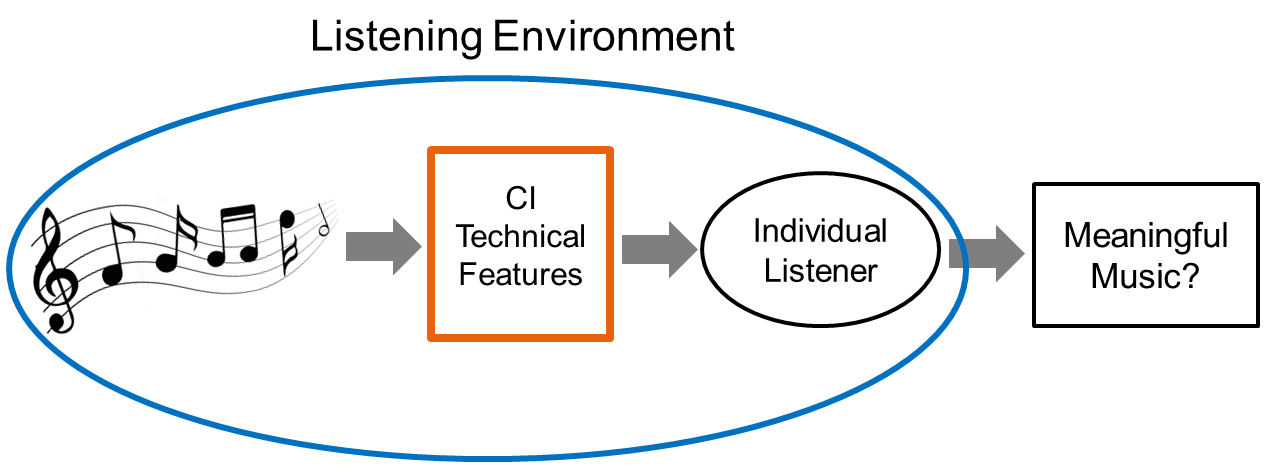See also: Articles on Music, Hearing Loss, and Hearing Devices 
As you read this website, keep in mind the following:
-
People with hearing loss can differ in many ways.
-
Some information may be more similar to your situation.
-
Pick and choose the information most useful for you.
CI Technology and Music: Music Perception and Enjoyment
Information for Cochlear Implant (CI) Users and Family
Music listening by cochlear implant users is affected by the following factors:
-
Type of music
-
Listening environment
-
Individual listener
-
Cochlear implant technology
This page focuses on cochlear implant technology and its effect on music.
1, 2
Music does NOT sound 'normal' through a cochlear implant (CI).
What does music sound like through a cochlear implant?
Here are some musical examples and simulations of music as conveyed through a cochlear implant.
[Note: These simulations represent the electrical signal conveyed by the cochlear implant to the auditory nerve. That signal is then interpreted by the brain. The listener's brain will modify this signal to a greater or lesser extent, depending upon their auditory profile and life experiences. Therefore, these simulations only represent the signal sent by the CI, not exactly how it will actually sound to each individual CI user.]
-
A simple piano tune
-
A simulation of what the piano tune sounds like through a cochlear implant
-
A simple saxophone tune
-
A simulation of what the saxophone tune sounds like through a cochlear implant
Many CI users report that tone quality of music is less pleasant---even unpleasant---with the CI compared with normal hearing. However, CI users vary a lot in how much they enjoy music. Other pages in this website explain many factors that can influence why music may sound more or less pleasant. Some CI users have achieved music enjoyment through dedicated practice listening and playing music over time. Other CI users have more residual hearing, which can help music sound more like typical hearing. There are many different stories that you will find throughout these webpages.
Despite the limitations to music perceptions in some CI users, different factors can help music listening with a cochlear implant.
- Click this link to learn more about information that describes strategies or training programs that help music listening and making and some stories from musicians who use CIs.
CI technology is better suited for speech than for music. Why?
-
Speech sounds tend to be less complex than music.
-
Speech usually involves one person speaking at a time. Music is often made up of complex combinations of singers or instruments.
-
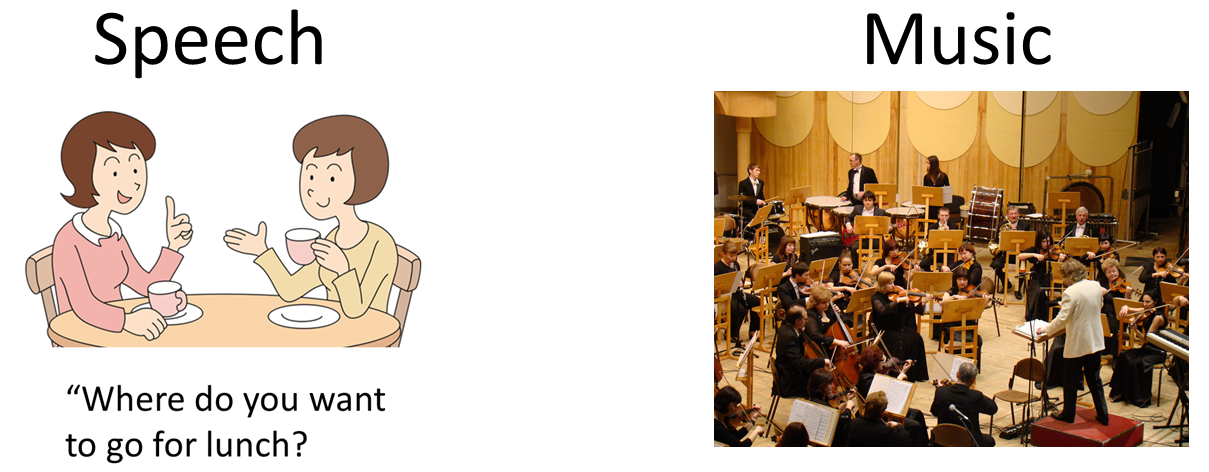
-
Speech has a more narrow frequency range than music.
-
CI technology emphasizes the frequencies that are important to speech.
-
Musical instruments often play sounds higher or lower than pitches conveyed by CI technology.
-
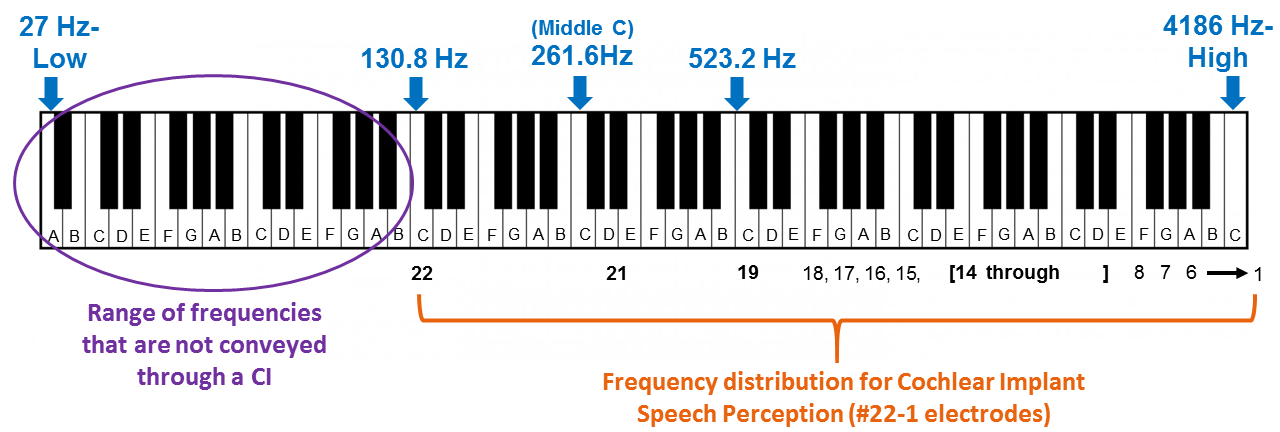
To appreciate music, a cochlear implant recipient needs to perceive a much wider range of frequencies than to understand speech.
-
CI technology processes and simplifies spoken and musical sounds.
-
Speech can be understood even when simplified by a CI.
-
Musical notes and tone quality are degraded (damaged) when CI processing simplifies the sound.
-
-
The processing of musical sounds by a CI might be compared to what happens to vegetables in a food processor.
-
You put in individual carrots, tomato, or celery into a food processor.
-
After processing, the individual shapes, colors, and flavors of each vegetable are lost.
-
-
Similarly, the sounds of individual notes and specific musical instruments are processed by a CI.
-
After the processing, the individual notes and sound qualities are lost. This makes music hard to understand and damages the beauty of the sound.
-
-
Some parts of music sound better through a CI than others.
Music is made up of the following building blocks:
-
Temporal Elements: how long or short, or how fast or slow the notes are.
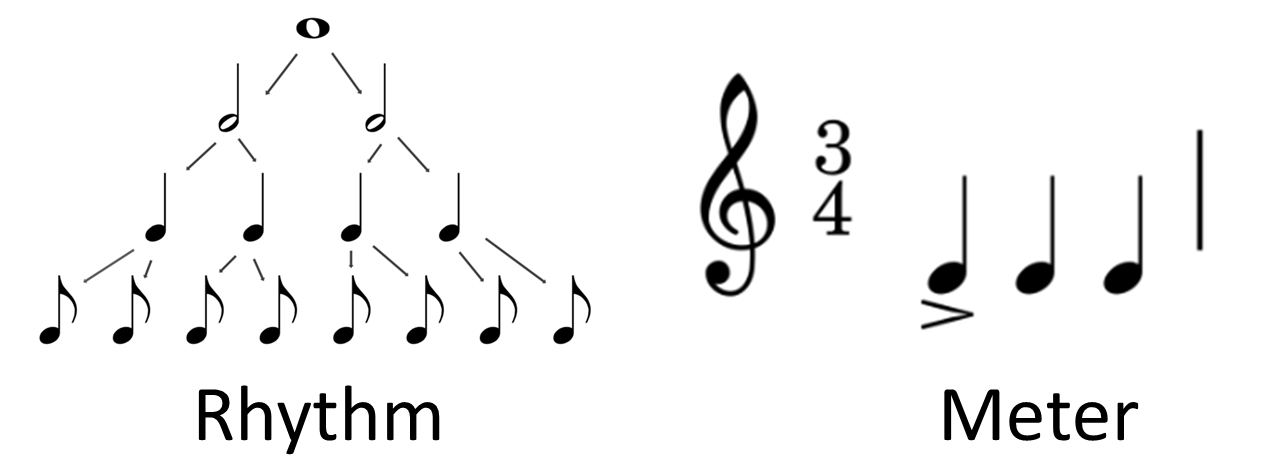
-
Rhythm refers to patterns of long and short notes. For people who read music, this includes sequences such as whole notes, half notes, quarter notes, and eighth notes.
-
Meter means the way in which rhythm patterns are grouped into repeating patterns. Some people might call this the 'beat' of the music. For example, a waltz is organized in patterns of 3 beats. A march is organized in patterns of 2 beats.
-
Tempo is the overall speed of music, from very slow to very fast.
CI users typically are as accurate on temporal elements as people with normal hearing.
-
Pitch Elements: how high or low each individual note is.
-
The notes at the left of the piano keyboard sound the lowest. As you play the notes from the left to the right, the notes sound higher.
-

-
Pitch is one of the hardest parts of music for CI users to hear accurately. Some CI users do not hear an actual pitch---they hear more of a 'thud' or noise. Some CI users can hear larger pitch changes.
-
Melodies are made up of a sequence of pitches. A sequence of pitches may be recognized by a name, such as "Twinkle Twinkle Little Star" or "Jingle Bells."
-
Harmonies are made up of several different pitches playing at the same time---such as a chord played on the piano.
-
CI users tend to be less accurate in recognizing melodies or understanding harmonies than people with normal hearing.
-
Small changes in pitches are especially hard to hear.
-
Pitch perception does not tend to improve with more general CI experience.
-
Some CI user improve pitch perception with extensive training and a lot of focused practice over time.
-
-
-
Timbre: the unique tone quality of different instruments or singing voices.
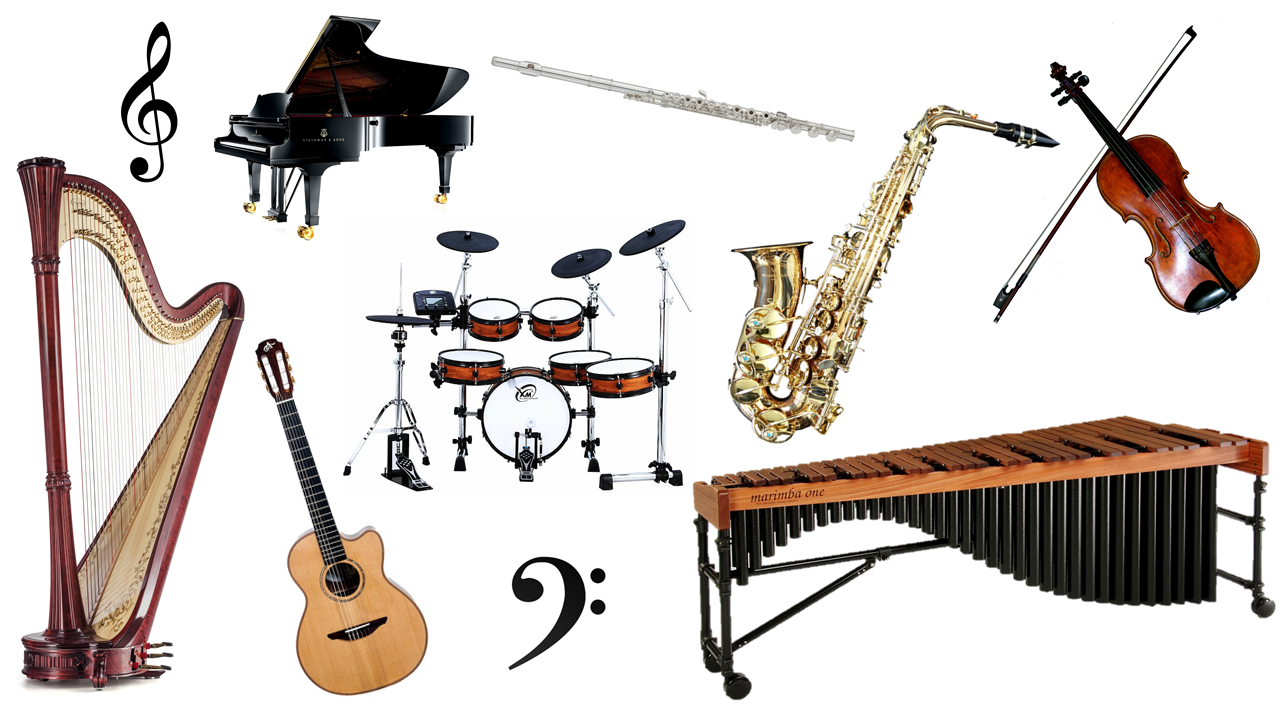
-
Timbre makes the sound quality of one instrument different from another, such as a piano as different from a saxophone or violin.
-
Timbre allows you to recognize different singers---for example, Elvis vs. Frank Sinatra.
-
Timbre is an important part of what makes music sound interesting.
-
CI users are typically less accurate in recognizing musical instruments by tone quality than people with normal hearing.
-
Timbre recognition can improve with training.
-
Some timbres may sound better than others through the CI.
-
-
-
Dynamics: how soft to loud music is.
-
Musicians often change the dynamics of the music to make it more expressive.
-
Music that is too loud can be physically uncomfortable for CI users.
-
Music that is very soft can be difficult for CI users to hear.
-
Some CI users say that "a moderate volume is best...55 to 85 dB range."
-
Cochlear implant technology limits the dynamic range of music---how much change there is from soft to loud.
-
This can reduce the expressiveness of music.
-
-
-
Lyrics: the words to songs, which are sung.
-
Cochlear implants have been designed to transmit speech sounds. CI users report that sung lyrics are harder to understand than spoken words but easier to understand than musical pitches.
-
Lyrics will be easier or harder to understand through a CI depending upon many factors.

-
Fast lyrics are more difficult to follow.
-
Unfamiliar vocabulary is harder to understand.
-
Singers who use clear enunciation make lyrics easier to understand.
-
A loud instrumental accompaniment makes lyrics harder to understand.
-
Cochlear implant users tend to be less accurate than people with natural hearing on lyric recognition.
-
-
Other factors influencing music listening:
-
Musical Complexity: The complexity of music varies greatly, depending upon how many musicians are playing and the type of music.
-
CI users tend to prefer simpler sounds, such as soloists or small ensembles.
-
Music with a clear beat, easy lyrics, and simple style is often preferred.
-
Through trial and error, each individual can discover what songs and styles of music they enjoy.
-
-
Familiarity: Being familiar with a song can help people understand music. The more familiar one is with a song, the easier it is to understand the lyrics and to make sense of the notes.
-
Many CI users suggest starting the musical journey after implantation with songs that were familiar before hearing loss.
-
Listening to songs many times can gradually increase familiarity and enjoyment.
-
Enjoyment can improve with music training, a lot of focused listening, and changing expectations.
-
The incoming signal doesn't change, but the brain 'learns' to use the incoming sound more effectively. This is called neuroplasticity.
-
The sound quality will not become 'normal' but music can gradually become easier to understand and more enjoyable.
-
Click here to learn more about music training for CI users.
-
CI users with more residual hearing can use that to help make sense of what they hear.
-
CI users who grew up with cochlear implants are accustomed to how music sounds through a CI.
-
CI users can enjoy the rhythmic part of music.
Are some brands of cochlear implants (CIs) better for music than others?
-
Most brands of CIs have some users who really enjoy music and others who are very disappointed with music (Looi, Gfeller, & Driscoll, 2012; Gfeller et al., 2012; Limb & Roy, 2014; Gfeller, Driscoll & Schwalje, 2019).
-
Some CI users report that specific processing strategies or technical upgrades have improved their music enjoyment.
-
Strategies that improve music for some CI users do not make a difference for others. (Gfeller, Driscoll & Schwalje, 2019)
-
-
Natural (residual) hearing is much better than electrical hearing (the stimulation provided by the CI) in conveying pitch and timbre (Gfeller, Driscoll, & Schwalje, 2019).
-
Technology or surgical approach that preserves residual hearing tends to result in better music perception (Gfeller et al., 2012; Gfeller, Driscoll & Schwalje, 2019).
Important similarities and differences between CIs and hearing aids (HA) for music listening.
-
Hearing aids (HA) make sounds louder (amplify).
-
This can make the sound more audible for people with mild and moderate losses.
-
-
CIs process and extract sounds, and directly stimulate the auditory nerve.
-
Music sounds more 'natural' through a HA than a CI.
-
Wearing hearing aid with their CI helps some people make sense of music.
-
-
Both HAs and CIs have some difficulty processing rapid, complex, or very loud musical sounds.
-
Greater residual (preserved) hearing tends to make music sound more full and natural for both CI and HA users.
References
Gfeller, K., Driscoll, V., & Schwalje, A. (2019). Adult cochlear implant recipients’ perspectives on experiences with music in everyday life: A multifaceted and dynamic phenomenon. Frontiers in Neuroscience, 13, 1229.
Gfeller, K., Jiang, D., Oleson, J. J., Driscoll, V., Olszewski, C., Knutson, J. F., Turner, C., & Gantz, B. (2012). The effects of musical and linguistic components in recognition of real-world musical excerpts by cochlear implant recipients and normal-hearing adults. Journal of Music Therapy, 49(1), 68–101.
Limb, C. J., & Roy, A. T. (2014). Technological, biological, and acoustical constraints to music perception in cochlear implant users. Hearing Research, 308, 13-26.
Looi, V., Gfeller, K, & Driscoll, (2012). Music appreciation and training for cochlear implant recipients: A review. Seminars in Hearing, 33(4), 307-334.
Click here to review references used in preparation of this website.
1. All images on this website are used under Creative Commons or other licenses or have been created by the website developers.
2. Click here to access the sources of images on this page.
